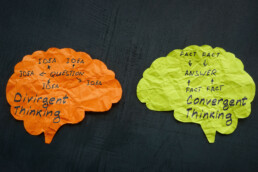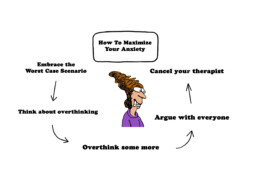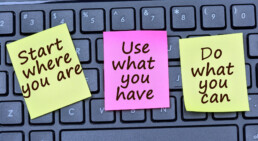The Value of a Planner
How good is your memory? Is short term memory a problem for you? Or is long term memory more difficult? Or are they equal? My memory is all over the place. I went to the market to buy juice and bought everything I hadn’t needed, but no juice. That’s what makes a list important. It’s planning ahead.
To know when your appointments are, or things you want or have promised to do, it makes sense to write them down. And you must write them all in the same place. Thus, a planner. Or a calendar of sorts will do. That way you have one place to turn to every day to see what you’ve got going that day, or to look ahead at the week, or even the month.
There are so many planners out there I could spend hours telling you about them and still not get through them all. There are entire planner systems designed for making and achieving goals. Someone has created a planner for just about every aspect of life. Paper or electronic, you could plan yourself to your last breath. Or you could keep a simple calendar and look at it regularly.
 My dentist always asks me about scheduling an appointment six months out from my current appointment. E.g. “Are you free September 4th?” How would I know that? Fortunately, I have a calendar in my phone and can scroll to September, check the date, and enter the dentist appointment. Now I won’t schedule anything else for that time. I may even set a reminder to make sure I leave the house on time.
My dentist always asks me about scheduling an appointment six months out from my current appointment. E.g. “Are you free September 4th?” How would I know that? Fortunately, I have a calendar in my phone and can scroll to September, check the date, and enter the dentist appointment. Now I won’t schedule anything else for that time. I may even set a reminder to make sure I leave the house on time.
I have a friend I have dinner with every Saturday. If I call her earlier in the week to make a plan (in case we need a reservation), she never has an answer. Only on Saturday afternoon can she come up with an idea. She does not have a planner.
To take charge of your life you need to plan how your life will unfold rather than just letting it happen.
Life is never as easy as we plan it to be; however, having a planner makes the bumps of real life easier to deal with.
- Sydney Metrick
Goals vs. Resolutions
Are you a person who makes a list of resolutions at the start of a new year? Do you carry through with them or find that they have fallen by the wayside?
The problem with resolutions is there is little to define them except knowing what it is you want (or don’t want).
Goals, on the other hand, give you a framework to make it more likely you will end up with what you had intended. I’m sure by now you’ve heard of SMART goals. It has become a bit of a buzzword.
Let’s say you want more time in the evenings to relax.
First, your goal must be Specific. More and less are not specific words. If you want “more” free time, you need to define what that looks like to you.
Next is Measurable, this is part of being specific. How much time do you want for evening relaxation? 20 minutes? Two hours?
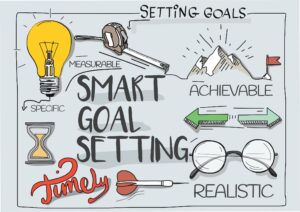 A is for Achievable. It is not likely that you can set aside two hours every evening for relaxation; the 20 minutes, however, is much more achievable.
A is for Achievable. It is not likely that you can set aside two hours every evening for relaxation; the 20 minutes, however, is much more achievable.
Is it Realistic? Given your life and schedule, what would you have to give up or do much faster to carve out two hours of free time every evening?
Finally, Time sensitive. When will you begin doing this? Frequently, goals are something that we need to work up to. Maybe you start with five minutes and increase steadily from there. At what point will you reliably have that desired amount of relaxation time?
Bonus attribute: Accountability. While not required for a SMART goal, it makes success more likely – and sometimes easier. Is there someone, personal or professional, who can check in with you weekly to make sure you’re keeping up?
There you have it—a formula for success. And, since every day is the first day of a new year, you do not need to wait for January to set new goals.
- Sydney Metrick
How Does Impulsivity Show Up in Your Life?
Do you interrupt when others are talking? Are you just skimming this blog? When you see something you like but don’t need, do you buy it anyway? Are you likely to jump out of something you’re doing into something more interesting? Do you act without thinking? Do have impulsive behaviors?
If you have ADHD, some or all of these may feel familiar.
Is there a solution? Not really, sad to say. It’s matter of calming down and asking yourself if you really need to do or say something right at that time. Awareness is key.
 Awareness, however, can be difficult when dealing with impulsive behaviors – that’s sort of the point.
Awareness, however, can be difficult when dealing with impulsive behaviors – that’s sort of the point.
Google “awareness,” “practicing awareness,” or something similar and you will get results from just about every discipline imaginable – from the American Psychological Association to Harvard Business Review. Of all the Tips, Tools, Exercises, and Ways to become self-aware, there are three out there that seems to come up most often:
- Meditate: Find some way to spend some time with just your brain and learn how to slow things down.
- Keep a Daily Journal: Write down all your reactions, impulses, feelings. No judgements, just what happened.
- Ask a Friend: Talk to someone who cares about you and will tell you the absolute truth – whose opinion matters to you. Ask about your strengths and annoying habits.
Just like with any habit, awareness takes time, practice, and patience. Keep at it, though, it’s worth the trip.
-Sydney Metrick
Are you a divergent or convergent thinker?
…or maybe a little of each? Divergent thinkers are primarily intuitive. A word will unleash a wide variety of remote and original associations. Most creative people and people with Attention Deficit Disorder are divergent thinkers.
Convergent thinking is analytical and linear. STEP is a useful way to think about how convergent thinker’s function. S-strategies, T-time, E-energy, P-perseverance. Instead of being blocked by a new project or assignment, a convergent thinker will come up with a strategy. They will imagine how much time will be needed for the whole and for each part. By doing so they’ll know how much energy is required, and commit to persevering.
Divergent thinkers often find convergent thinking challenging. On the other hand, convergent thinkers tend to find divergent thinkers a bit insane.
Alas, at some point we all need to have some convergent thoughts. By thinking of the STEPs and applying them, we can take on a new task or project without a big confrontation going on in our heads.
- Sydney Metrick
The Downside of Lists
Do you make lists to help you remember tasks, shopping, phone numbers and other information? Are they to serve as daily reminders? Do you have one very long list, or multiple lists on various scraps of paper or in multiple notebooks?
One person I know has at least nine notebooks, countless pieces of paper, and notes on the back of newspapers and fliers. Many of the lists contain duplicate or even triplicate information!
Sadly, he can rarely find the information he’s looking for, has to research again and maybe start another list.
So, what’s the answer?
For my friend, the first step is consolidation. Once all the lists are in one place, he’ll work on the habit of containment. That will take some time; as he’s committed to the process, though, I’m hopeful.
The next question is, what is each list for?
For the standard to-do list, I suggest two lists: one weekly, one daily, and with the same categories. As you cross things off your daily list, or move them to a different day, you can review your weekly next and decide what would best fit into the space left by a “done!”
If your to-do list has a sub-list – such as what to get once you are at the grocery store – there are two basic options.
- Keep it on the same page so you don’t lose it.
- Keep it on a different page dedicated to the sub-type in the same notebook so that it doesn’t confuse your primary list.
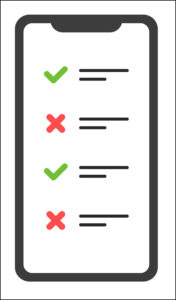 For other types of lists, consolidation is key. For general information lists (books to read, movies to see, names of distant relatives, etc.) using separate sections of the same notebook for different categories can prevent confusion. Special projects may deserve a separate notebook with a section dedicated to lists for the project.
For other types of lists, consolidation is key. For general information lists (books to read, movies to see, names of distant relatives, etc.) using separate sections of the same notebook for different categories can prevent confusion. Special projects may deserve a separate notebook with a section dedicated to lists for the project.
The point is this: if you went to the effort to write the information down, go to the effort of keeping track of it. Keeping track is simpler by using a system of defined steps that WORKS FOR YOU. If paper works for you, great. If you prefer lists in your phone, that’s great too!
Lazy?
Accompanying the hot weather of recent weeks, the little voice in my head that tells me to put things off has gotten very persistent. I was soaking some tomatoes to detoxify them and planned to soak apples afterward. That’s when that sneaky voice popped up and said, “you can soak the apples later.” Fortunately, the sensible part of my thinking caught that. Soak the apples later? All I have to do is take the tomatoes out of the bowl and put the apples into it.
As I lay on the couch reading and waiting for the dryer buzzer to go off, the load soon dries. The lazy voice suggested the clothes could wait until I’d gotten up for something more important, like a glass of water. If I did that, I’m sure the voice would come up with something new when I did get up.
That inner voice, usually known as the inner saboteur, is all about “later.” As if later things will be easier or there will magically be an increase of motivation. I admit I cannot see the future. And some tasks could be easier at a different time of day and motivation does have a way of coming and going. All that said, even when vital, I am rarely motivated by laundry.
While that little voice never goes away, it is possible to recognize it and ignore it. Or, if you don’t want to be rude, you could acknowledge it and then choose not to take its advice. When you pay attention to what your voices are telling you, seeing why you’re not getting things done is much easier. Also, when you pay attention, you take yourself off autopilot and allow your sensible part have a say too.
-Sydney Metrick
Avoiding “Worse Case Scenarios”
Do you ever put off something you need to do because you’re thinking doing it will be difficult or unpleasant in some way? Your mind is attempting to protect you from the possibility of failing by projecting the “worst case scenario” as the likely outcome.
That story in your imagination is powerful enough to keep you from doing something you actually need to do. As the Temptations sang:
“A cozy little home out in the country with two children, maybe three.
I tell you; I can visualize it all. This couldn't be a dream, for too real it all seems.
But it was just my 'magination, once again.
Running away with me.”
Since what you imagine can seem so real, why not use it to picture positive experiences and outcomes?
Here’s one way to do that. Let’s say your task involves getting your financials ready for your tax preparer. In previous years this task has been a painful slogging eating up days of your life. Why on Earth would your imagination push you towards avoidance or procrastination?
 One solution is to imagine how wonderfully easy the task will be by approaching it in a different way. I frequently suggest people take on big tasks in little bites. So dedicate, say, 30 minutes a day for a week to get everything together.
One solution is to imagine how wonderfully easy the task will be by approaching it in a different way. I frequently suggest people take on big tasks in little bites. So dedicate, say, 30 minutes a day for a week to get everything together.
This is a two-pronged attack:
- You are using your imagination to see this job as an easy thing. And 30 minutes of any task is doable.
- Getting a chunk of work done on a daily basis gives you a feeling of accomplishment which can make the next day’s 30 minutes easier – and validating your imagined experience!
You can already imagine how great you’ll feel when you totally complete the work; why not use that tool to feel good about the process? You can enhance the experience in any way you want.
Step into that picture and claim it as real.
The more you start thinking positively, the easier things become.
- Sydney Metrick
There is No “Right Time” Just Time and What You Do with It
“Congratulations, today is your day.” writes Dr. Seuss in the first line of “Oh, the Places You’ll Go.”
I know procrastinating can be so persuasive yet putting things off to a better time can result in: guilt, anxiety, a poor job, never getting the “thing” accomplished, or forgetting it even existed.
There are so many ways to procrastinate. Do any of these sound familiar:
- I’m tired,
- I’m hungry,
- I’m not in the mood,
- I just want to finish this chapter.
Or, maybe you have better sounding excuses like:
- I have other things to do,
- This is low on my priority list,
- My child broke a bone.

Then there are the excuses we don’t like to say out loud:
- I don’t know how,
- I’m scared,
- It’s too hard,
- I don’t want to.
There’s a Chinese proverb that says, “in times of great winds, some build bunkers and others build windmills.” Bunkers can be good – they provide protection. Windmills, on the other hand, provide opportunity. The question becomes, when you are in the next windstorm, are you going to try to keep the bad – and good – out, or are you going to create an opportunity?
So how will you approach 2022? Are you looking for any improvements? Think Goals rather than resolutions. Have you plans? Start dates? Support?
Let me know if I can be of assistance. 😊
- Sydney Metrick
If Not Now, When?
Are you familiar with Dr. Seuss’s, “The waiting place?”
“Waiting for a train to go or a bus to come, or a plane to go or the mail to come,
Or the snow to snow or waiting for a Yes or a No, or waiting for their hair to grow.
Everyone is just waiting.”
Are you waiting for the time to be “right” to start a task or a project, especially a big project or a less than exciting task? The truth is when a project feels too big to know where to start, or a task is tedious, the time will only be right when you actually decide to start.
There are many reasons for procrastination and only one solution.
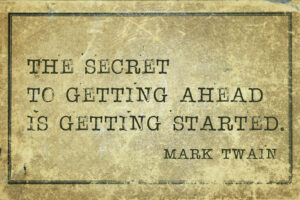 Starting.
Starting.
Fear not. Starting is not the same as finishing, and knowing the best place to start is not necessary. Starting just means taking one small step…then another.
Sometimes a project or task can be easier with chunking. That means breaking it into either time chunks, e.g. “I will spend ten minutes on this,” or chunks of items or work. For example, just go through one pile, or writing one page.
If “now” really isn’t the ideal time to start, then schedule a “now” and stick to it!
You may be familiar with the Chinese proverb that says: “The best time to plant a tree was 20 years ago. The second-best time is now.” So, forget about waiting.
-Sydney Metrick
Are You Sleeping?
Does this ever happen to you? You go to bed at a reasonable hour and you’re pretty tired, but all you do is toss and turn. Sleep eludes you. It might be that you can’t shut down because your mind is churning out endless thoughts.
Or maybe you do fall asleep but wake in the middle of the night and just can’t get back to sleep.
Issues with falling and staying asleep are especially common in people with ADHD. When you finally do fall asleep you may find it hard to wake up.
There are a number of causes, but solutions are also available.
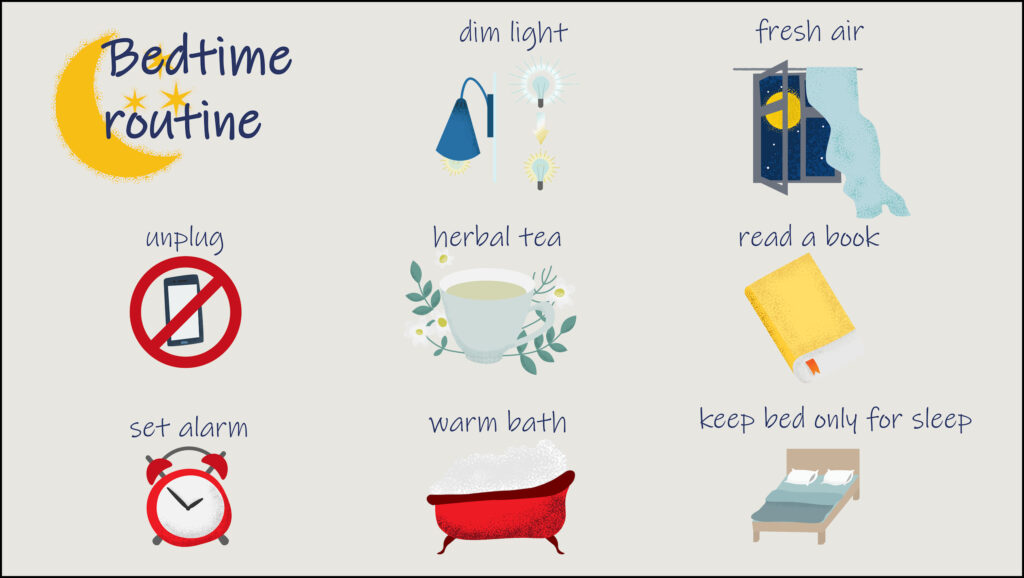 An erratic sleep schedule or no sleep schedule at all is one area that can contribute to poor sleep. Developing a consistent bedtime routine can train your brain and body to get tired at a particular time. If you’re more alert in the evening and often stay up until the wee hours, you might work on gradually moving back your bedtime, perhaps half an hour each week until you find a time that feels right for you.
An erratic sleep schedule or no sleep schedule at all is one area that can contribute to poor sleep. Developing a consistent bedtime routine can train your brain and body to get tired at a particular time. If you’re more alert in the evening and often stay up until the wee hours, you might work on gradually moving back your bedtime, perhaps half an hour each week until you find a time that feels right for you.
Deciding how many hours of sleep you want/need will help. If your body says seven hours and you stay up until 3, getting your day started might put you out of sync with work or family.
Let’s say you decide you want to go to bed by 11:30 every night. Start winding down at 11. This means preparing your room for sleeping, doing your bedtime routine whatever that may be, and turning off your computer, phone, and television.
It takes a while to accommodate this type of change so be prepared to make small adjustments.
You can improve sleep by paying attention to what you eat and drink and when. Some herb teas are soothing and relaxing. It’s also good to avoid large meals and alcoholic beverages for at least three hours before going to bed.
Finally, make sure your room and bed are comfortable and quiet. Here in Mexico, all-night parties, barking dogs, and cohetes - the rockets that accompany the many celebrations are all sleep interrupters. Earplugs and white noise machines can moderate outside noise.
And the address is…?
If I invited you to my house and only gave you the name of the town, is it likely you’d ever find me? Having the neighborhood would give you a slightly better chance, but only with the street name and the house number could you pinpoint the exact location.
 Let’s substitute my house for yours. Consider some of the important things you misplace with regularity: for example, your keys, or shoes, or important papers. You know these items are in the house somewhere, but which somewhere? Maybe your papers are in some pile or stuffed in a box; or your keys are on the table or counter or in a jacket pocket. Perhaps you kicked off your shoes at the door, or they might be under the couch, or the pair you want is in that pile of random family shoes.
Let’s substitute my house for yours. Consider some of the important things you misplace with regularity: for example, your keys, or shoes, or important papers. You know these items are in the house somewhere, but which somewhere? Maybe your papers are in some pile or stuffed in a box; or your keys are on the table or counter or in a jacket pocket. Perhaps you kicked off your shoes at the door, or they might be under the couch, or the pair you want is in that pile of random family shoes.
This can be worse for something important that you use irregularly – like the extra key to your parents’ garage.
These items are lacking a home of their own. Determining places for important things to “live,” remembering the “address,” and developing the habit of putting important things into their homes when you finish using them will save you time and stress. Imagine always knowing where your keys are!
I live with a somewhat disorganized person. To make this process easier for him, I created labels for his drawers and bins for certain types of items. Having them is one part of a process that works for him. What would work for you?
Need help? Here I am.
-Sydney Metrick
A Winner Is ...
… just a loser who tried one more time. George Leonard, in his book Mastery, reminds us that it may take many steps to arrive at a destination. That might look like two steps forward and one step back, or even one step forward and three steps back. The key is realizing the steps backward or even the long plateaus with no advancement are not reasons to quit.
People with attention deficit disorder are likely to try things that are new and exciting, but when they become boring or difficult, well... I took lessons in guitar, clarinet, piano, and flute and can play nary a one because I gave up at the plateau. If I realized then that a plateau was a great time for integration, I might play a musical instrument today.
Working towards goals may mean developing new habits that are not immediately comfortable. A plateau gives you time to acclimate and work that habit into your mindset as well as your routine.
 Back steps are opportunities for evaluation. You might check to see if you’re on the “right path” for the “right reason,” and using the “right approach.” Everyone finds themselves doing something that doesn’t feel great. That’s a time to check in with your what, why, and how of the thing to make sure you are being true to your values.
Back steps are opportunities for evaluation. You might check to see if you’re on the “right path” for the “right reason,” and using the “right approach.” Everyone finds themselves doing something that doesn’t feel great. That’s a time to check in with your what, why, and how of the thing to make sure you are being true to your values.
Think about a goal you have for 2021. How committed are you to achieving it? Remember the quote by John Assaraf: “If you’re interested, you will do what is convenient; if you’re committed, you’ll do whatever it takes.”
Need help? Here I am.
- Sydney Metrick
What, Me Worry?
 There’s a good chance that your worry and anxiety have gone up a few notches this past year. In addition to the overwhelm you may experience in your personal life, we have a pandemic in an election year, and terrible things happening climate-wise in various parts of the country and the world.
There’s a good chance that your worry and anxiety have gone up a few notches this past year. In addition to the overwhelm you may experience in your personal life, we have a pandemic in an election year, and terrible things happening climate-wise in various parts of the country and the world.
Though you still may take action to make a difference, there’s only so much you can do on a grand scale. Your greatest power lies in your personal life, where you can change YOUR beliefs and YOUR habits around dealing with everything that is going on.
Unfortunately, some of the stories you tell yourself about who you are and what you can truly achieve come from misguided attempts to keep you safe. Based on fears and insecurities your inner saboteur will say, “you can’t,” “you’re not,” “you shouldn’t” and flood you with feelings that prevent you from doing and being what’s important for you.
When you repeatedly tell yourself something is difficult, you don’t have time, or anything that diminishes you, it becomes your reality. To create a different reality, interrupt that inner saboteur and tell yourself something different.
Catch yourself. Change your words. Change your story. Start to change your life.
Need help? Here I am.
-Sydney Metrick
Designing an Uncertain Future?
Have you heard anyone talk about “when things return to normal” or possibly “we are moving to ‘a new normal’”? Normal is defined as usual or typical.
Normal is a problematic concept in a number of ways because it is “in the eye of the beholder” and influenced by other problematic concepts like:
- Habits
- Self-concept
- The future
 When you do or think something repeatedly over time it becomes a habit. You may recall the four-step grid for developing a new habit. It starts with the awareness that what you are doing isn’t working for you in the present. That’s Unconscious incompetence. Working on a new behavior can be challenging—conscious incompetence. As the new behavior begins to become a regular activity it’s conscious competence. Finally, it’s so ingrained that you become unconsciously competent. With habits, normal is generally unconscious.
When you do or think something repeatedly over time it becomes a habit. You may recall the four-step grid for developing a new habit. It starts with the awareness that what you are doing isn’t working for you in the present. That’s Unconscious incompetence. Working on a new behavior can be challenging—conscious incompetence. As the new behavior begins to become a regular activity it’s conscious competence. Finally, it’s so ingrained that you become unconsciously competent. With habits, normal is generally unconscious.
Your self-concept is tied to beliefs and habits. You hold beliefs about yourself that influence your actions. As your actions or behaviors change your image of yourself shifts. How you previously saw the way you were as normal for you might be quite different with new behaviors.
Your future exists in your imagination. We also have collectively imagined futures, like space colonies and cures for diseases. These imaginings can become goals and perhaps come to pass. But you never really can predict what, if, or when.
The “solution” for your definition of normal is to imagine what you’d realistically like life to look like over the next months, or years, and do what you can to make that happen.
-Sydney Metrick
We’ve Been Forced to Change
Having to shelter in place drives home Newton’s first law, known as the law of inertia. You may wonder how this applies to you. The law says an object at rest stays at rest and an object in motion stays in motion – with the same speed and in the same direction unless something pushes or pulls it. Basically, as objects, we don’t change our behaviors just because it’s a good idea. It might make sense to change, but oh the effort you feel you must expend.
When you don’t seem to have any choice in the matter, most of you will comply and find ways to make changes. You might do it kicking and screaming, or you might get creative. The bottom line is you can, and you do, learn to do things differently. If the past ways are no longer working, you get to look for ways to create a different and even better present and future.
 This is applicable across the board. No need to adhere to old habits that don’t work just because you’ve always done things that way, and it’s easier to just follow that beaten path.
This is applicable across the board. No need to adhere to old habits that don’t work just because you’ve always done things that way, and it’s easier to just follow that beaten path.
Think of a change you say you want to make. What’s stopped you? Lack of time, knowledge, remembering, fear of failure, a story about how difficult it will be? Is the change really important to you? On a scale of zero to ten, how important?
If the new behavior feels really important and you have the time, materials, and/or tools what else do you need? Commitment? Accountability? Knowing what the first step is and how you will take it?
Guess what? It’s all in your head! You know the terms “live as if,” and “fake it ‘til you make it”? Well, those things work because the brain sees imagined truth just like truth.
Here’s a way to start:
- Imagine the time in the near future when your desired change is in place and you feel great.
- Spend a few minutes daily (or throughout the day) imagining yourself doing the things that make the change happen and then being in that imaginary future in which it has occurred.
The more you practice mentally, the easier it becomes in actuality. In fact, the mental practice will help make the actuality happen.
-Sydney Metrick
Why is Change so Difficult?
Do you remember Newton’s 1st Law of Motion? It says, an object at rest stays at rest and an object in motion stays in motion at the same speed and in the same direction unless acted upon by an unbalanced force. This is also known as the law of inertia.
Inertia. Something we all feel from time to time when we have a big project or task that feels difficult or boring. If you’re thinking inertia could be the sister of procrastination, you’d be right.
Inertia is also what makes life changes so difficult. You have a momentum going, maybe even for years, of being a certain way.

You do or do not do the things you’ve always done or not done. Maybe you really want to make a change, even a small change but it takes attention and practice. You need that unbalanced force Newton was so fond of.
For some, an outside force works best. Find someone willing to hold you accountable. Give them permission to check in with you regularly. An example conversation could be, “So, how’d it go with the task you intended to accomplish this week?” Then either, “Great, what helped you be successful with that?” or “Great, can you identify what got in the way? Can you avoid what got in your way last week, and be more successful this week?”
There’s an article in Entrepreneur Magazine entitled, 4 Cures for Chronic Procrastination, that nicely breaks down the process of getting through procrastination. In short:
- Narrow your focus
Just like eating an elephant, take it one bite at a time.
- Reward yourself for meeting your goals
Don’t push for perfection, if you’re doing it right more often than not, that’s a success!
- Hold yourself publicly accountable
There is nothing like knowing people are watching to keep you on task.
- Don’t lose momentum
Once you get started, keep moving!
- Sydney Metrick



